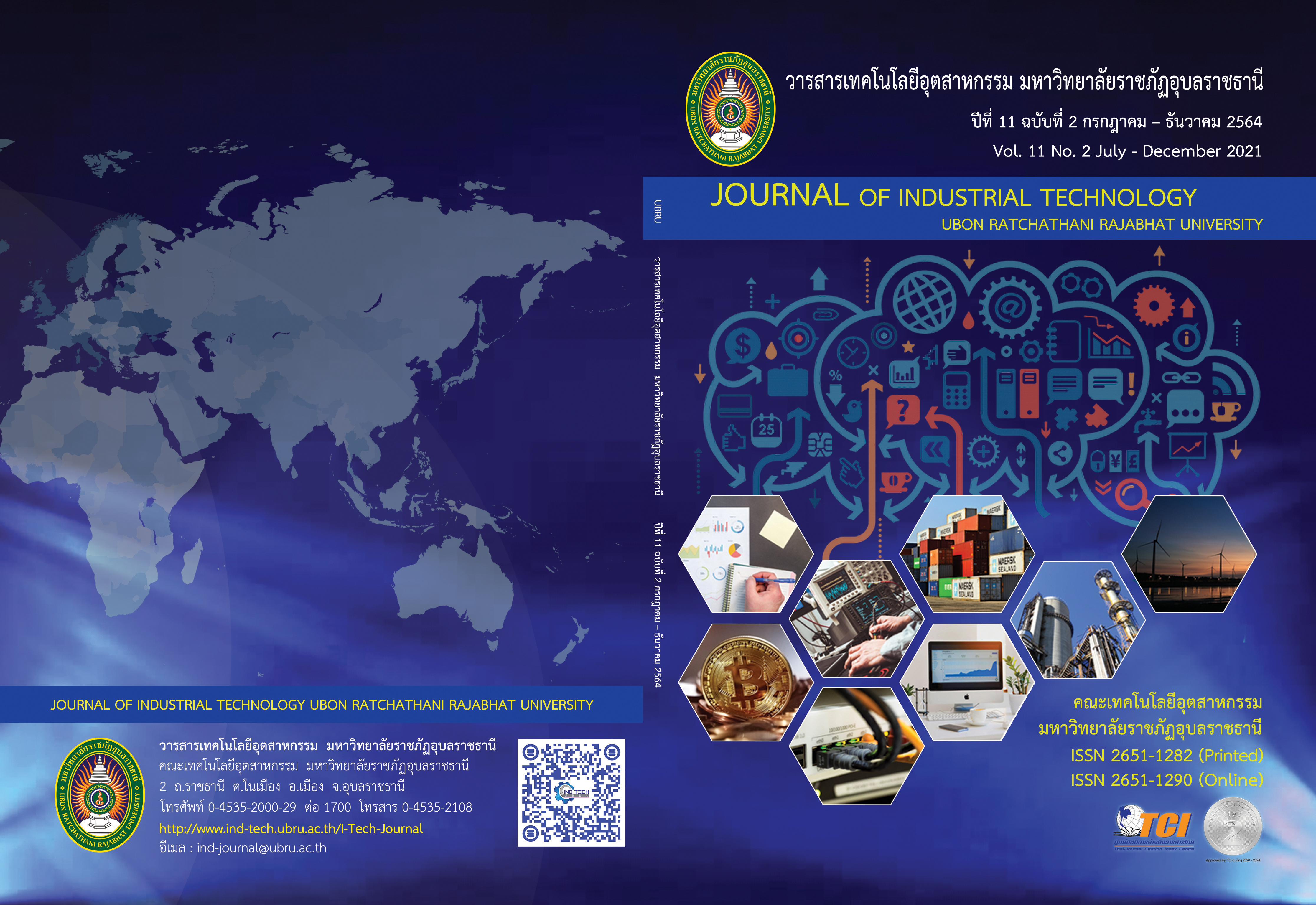การวิเคราะห์ปัจจัยที่มีผลต่อระยะลึกผิวแข็ง ด้วยการออกแบบการทดลองของการชุบแข็งผิวเหล็กกล้าคาร์บอนต่ำโดยใช้สารเร่งปฏิกิริยาหินปูนในกระบวนการแพ็กคาร์เบอไรซิง
Main Article Content
บทคัดย่อ
งานวิจัยนี้มีวัตถุประสงค์เพื่อศึกษาปัจจัยที่ส่งผลต่อค่าความแข็งและระยะลึกผิวแข็งในการชุบแข็งเหล็กกล้าคาร์บอนต่ำด้วยกระบวนการแพ็กคาร์เบอไรซิง โดยใช้สารเร่งปฏิกิริยาจากหินปูนและใช้หลักการออกแบบการทดลอง เพื่อหาปัจจัยที่เหมาะสมต่อค่าความแข็งและระยะลึกผิวแข็งของชิ้นทดสอบ ปัจจัยในการศึกษาแบ่งออกเป็น 2 ปัจจัย 3 ระดับ โดย ปัจจัยแรก คือ อุณหภูมิอบเพิ่มคาร์บอน ได้แก่ 900, 950 และ 1,000 องศาเซลเซียส ปัจจัยที่สอง คือ เวลาอบเพิ่มคาร์บอน ได้แก่ 2, 4 และ 6 ชั่วโมง ชิ้นทดสอบที่ผ่านการอบเพิ่มคาร์บอนที่ผิวแล้วจะถูกนำไปทำการชุบแข็งด้วยอุณหภูมิออสเทนไนต์ 780 องศาเซลเซียส เวลา 30 นาที แล้วจุ่มชุบในน้ำทันที จากนั้นนำไปอบเทมเปอร์ที่อุณหภูมิ 180 องศาเซลเซียส เวลา 1 ชั่วโมง ชิ้นทดสอบจะถูกนำมาทำการวัดค่าความแข็งด้วยไมโครวิกเกอร์สเพื่อหาค่าความแข็งและระยะลึกผิวแข็ง จากนั้นนำข้อมูลที่ได้ไปวิเคราะห์ผลทางสถิติด้วยโปรแกรม Minitab V.17 เพื่อศึกษาปัจจัยที่มีผลต่อค่าความแข็งและระยะลึกผิวแข็ง จากผลการทดลองพบว่าปัจจัยทั้งสอง มีอิทธิพลต่อค่าความแข็งและระยะลึกผิวแข็งโดยค่าความแข็งอยู่ที่ 523 HV. ที่อุณหภูมิอบเพิ่มคาร์บอน 900 องศาเซลเซียส เวลาในการอบเพิ่มคาร์บอน 6 ชั่วโมง
Article Details
บทความที่ได้รับการตีพิมพ์ในวารสารฯ ท้ังในรูปแบบของรูปเล่มและอิเล็กทรอนิกส์เป็นลิขสิทธิ์ของวารสารฯ
เอกสารอ้างอิง
Anil Kumar Sinha.Physical Metallurgy Handbook.The McGraw -Hill Companies, Two Penn Plaza, New York. 2003.
Lakhtin YM. Engineering Physical Metallurgy and Heat Treatment. Mir Publishers Moscow: Russia; 1990.
Pitsuwan P, Suwan P, Sengt Y, and Kongsong P. Influence of catalyst on surface hardening of low carbon steel by pack carburizing with mangrove charcoal powder. Journal of Industrial Technology Ubon Ratchathani Rajabhat University, 2018; 8(2): 1-12. (in Thai)
Thammachot N, and Homjabok W. The Efficiency of Natural Energizer in Increasing Carbon Content on Surfaces of Big Knives in the Pack Carburizing Process. The Sixth International Conference on Science; Technology and Innovation for Sustainable Well-Being, 2014: 189-95.
Srisuk S, Thammachot N, Banthao J, Nithikarnjanatharn J, Homjabok W, Mayai A, and Noyming S, A study of the relation of Temperature and Time effected on the big knives hardening in pack carburizing process by using calcium carbonate. Operations Research. 2019; (16): 202-7. (in Thai)
Montgomery Douglas C. Design and Analysis of Experiments. John Wiley & Sons Singapore Pte. Ltd. 2013.
Hwidi R, Izhar T, and Farah N, Characterization of Limestone as Raw Material to Hydrated Lime. E3S Web of Conferences. 2018; (34): 1-7.
ASTM E-140–02. Standard Hardness Conversion Tables for Metals Relationship Among. Brinell Hardness, Vickers Hardness, Rockwell Hardness, Superficial Hardness, Knoop Hardness, and Scleroscope Hardness.
Eur Lin P.P, Panagiotidis, and Antonatos A.S. Case depth determination by using Vickers micro – hardness test method at trsc / ppc sa. Hellenic society of non destructive testing. Chania-Greece. 2007; 11-4.
Elmi Hosseini S R. The Simulation of Case Depth of Cementation Steels According to Fick's Laws. Journal of Iron and Steel Researc. International. 2012; 71-8.
William F. Smith and Hashemi J. Foundation of Materials Science and Engineering. Fourth Edition. Steady-State Diffusion. 2006; 180-2.
Genel K, Demirkol M. Amethod to predict effective case depth in ion nitride steels. Surface and Coatings Technology. 1995; 116-20.
Aramide FO, Ibitoye SA. Isiaka Oluwole Oladele and Joseph Olatunde Borode. Pack Carburization of Mild Steel. Using Pulverized Boneas Carburizer Optimizing Process Parameters. Leonardo Electronic Journal of Practices and Technologies. 2010; 1-12.


